Please click on the thumbnails in this post for full-sized images.
Forty years ago Oman’s Southern province of Dhofar was in a state of civil war. The Sultan’s Armed Forces (SAF) was fighting to wrest control of the province from the guerrillas of the Popular Front for the Liberation of Oman (PFLO). By the winter of 1974-1975 the insurgents had been driven close to the Yemeni frontier due to the combined efforts of the SAF and an Imperial Iranian Brigade Group sent by Shah Reza Pahlavi, who had decided to assist a fellow absolute monarch, Sultan Qaboos bin Said, to withstand a radical leftist rebellion. By December 1975 the PFLO had been defeated, although elements of the movement continued low-level guerrilla warfare for the remainder of the decade.
The Dhofar war has been a topic of interest for me for nearly a decade now, and in particular the British role in this conflict. In July 1958 Harold Macmillan’s government signed a defence treaty with Qaboos’ father, Said bin Taimur, which led to the establishment of the SAF. The United Kingdom would provide loan service personnel from the three armed services to command and train its Omani counterparts, in return for which the RAF would be granted basing rights at Salalah airfield, outside Dhofar’s capital, and Masirah Island. When the Dhofar insurgency erupted in the early 1960s British officers became embroiled in combat, and successive governments (Labour and Conservative) waged an undeclared war to preserve the Sultanate.
This is not the place for an account of the war itself. I have already written on this topic, and other scholars such as Rory Cormac, Marc DeVore, Clive Jones, Walter Ladwig and James Worrall have also done much to enhance our understanding of this little-known conflict. There are also more populist accounts of the battle of Mirbat (19 July 1972), mainly glorifying the Special Air Service (22 SAS) soldiers who defended this fort against a PLFO attack.
In July and October 2014 I visited Oman in support of a battlefield tour of Dhofar, which gave me the opportunity to see the ground over which the SAF, 22 SAS and their local allies (the firqat forces militia), the Iranians and the PFLO fought. In the late 19th century the German historian Hans Delbruck visited the battlefields of the campaigns he studied, setting the foundations for what Western military professionals call ‘the staff ride’. Examining the ground over which armies fought allows academics and practitioners alike to bring the documentary evidence to life, and to try to understand the conditions and the challenges faced by past generations of servicemen at war. It can also sometimes reveal flaws in the written record, or the myth-making that often surrounds victory and defeat.
Sometimes the battlefield tour/staff ride can be a frustrating experience. In Europe, post-war reconstruction and development often acts against you. In Normandy, for example, once you move away from the beaches you find that there’s a hypermarket, a sports pitch or a corn field at the precise spot where you wished to put a ‘stand’, and to discuss what happened at this phase of (say) the Goodwood and Cobra offensives.
One the key differences with Dhofar is that whilst Oman has experienced astounding socio-economic growth since the mid-1970s, the province is still relatively untouched by modernity. Yes, Salalah has grown and has its luxury hotels, villages have established themselves around the firqa forts, and there is a single carriage road to the Yemeni border that is a triumph of engineering. But many of the key sites associated with the Dhofar war remain almost as they were during the campaign against the PFLO, complete with the remnants of sangars (firing positions), and even the odd stray 7.62mm cartridge, or a piece of link from a General Purpose Machine Gun’s ammunition belt.
Taking Mirbat as an example, the photo below is taken from the Jebel Ali, a small hill overlooking the town which the guerrillas seized prior to launching their attack. The PLFO sited crew-served machine guns on its summit to provide fire support for their comrades. As you can see, the hill gave them excellent fields of fire into the town and the fort.
Mirbat has been the subject of considerable myth-making. The PFLO force attacking the fort was around 200 strong (half the size commonly quoted in the more populist histories), and the fact that the SAS team defending it had 30-40 Omani gendarmes and firqat militiamen fighting alongside them has been downplayed in the mythology of the battle; had the local troops and tribesmen not fought as doggedly as the British special forces troops, the guerrillas would have overrun the latter. A break in the seasonal monsoon also enabled the Sultan’s air force (the SOAF) to strafe the guerrillas, and also to fly in by helicopter reinforcements which turned the tide of the fight.
Nonetheless, even with these qualifications the sight of the battlefield impresses the observer not only with the resolve the defenders – British, Omani and Dhofari – showed, but also the skill with which the PFLO attack was planned. Mirbat fits the description of ‘a close-run thing’.
It is also worth noting Dhofar’s micro-climate here. Between June and September every year the province experiences a monsoon (the khareef), which blankets much of its mountainous terrain (the jebel) under cloud cover. The constant drizzle of rain leads to a brief greening of the province, as shown below with this photograph of the old Davamand line, the defensive positions dug by the Iranians in late 1974.
This picture was taken last July. To put the reader in the scene, it is worth noting that there were no roads in Western Dhofar forty years ago. The SAF and the Iranians relied on helicopter support to move and for re-supply, at least up until the khareef affected air operations. Otherwise, the bulk of troop movement was on foot.
Imagine also being a soldier on one of these hills. You are dug in with your platoon and company in trenches. You have observation posts (OPs) to periodically occupy, and reconnaissance and fighting patrols to conduct. You also have to keep your rifle and other weapons serviceable and clean, and your superiors have the logistical challenge of keeping you fed, watered and with the ammunition and other accoutrements of war an infantry soldier requires. On top of all this, you will in all likelihood be ordered as part of a work party to gather defence stores such as barbed wire and corrugated iron and have to haul them up the hills like a pack animal. Soldiering here would not have been that much fun.
It was an important part of the Omani/Iranian war effort to hold positions on the jebel all year round, and to maintain blocking lines built from South to North (given the names Hornbeam, Hammer, and Davamand) to stop PFLO infiltration to the East, where the Dhofari nomads were concentrated and civil aid teams at work. The reality of that strategic decision was that SAF and Iranian soldiers had to shiver through the khareef and wage a war of constant patrolling and ambushing.
Now take a look at the picture below, which shows much the same terrain in October. You can see a track which follows the ridge-line down into the valley, which follows the old Iranian defensive line. Once the khareef clears, the vegetation starts to die, which gives you clearer fields of fire. The absence of the constant mist makes it less easier for a stealthy enemy to conceal its movements, and you have the clear skies which enable the SOAF and the Iranians to fly and also to spot hostile forces on the ground.
At the top of this track is an old defensive position known as Everest. This is the view I had last July:
Three months later, this is what you can see from Everest.
With the terrain and the climate it was difficult to believe that we were in the Arabian Gulf. Participants on this tour compared what they were seeing to the North Island of New Zealand, or Cyprus, or Kenya. Once you move north of the monsoon line you start to see ground which looks more like Arizona or New Mexico.
This picture below was taken in June 2014 at Difa, and the cloud cover from the khareef is clearly visible in the distance:
Difa was the location of a failed SAF offensive in January 1975 which was known as Operation Dharab. A second SAF attack eight months later (in conditions similar to the photograph below) was more successful, and ultimately led to the PFLO’s final defeat.
The campaign for Western Dhofar in 1974-1975 was characterised by fierce fighting. SAF and Iranian troops relied on close air support, artillery and even naval gunfire to rout the PFLO, which was augmented by 250 soldiers from the then-People’s Democratic Republic of Yemen. Above all, Britain was limited in the amount of aid it could provide. The loan service officers and 22 SAS could be committed fairly unobtrusively, but both the Conservative and Labour governments were loath to send combat units to fight, not just because the British armed forces were already overstretched by existing commitments, but because the presence of Western troops would have antagonised Arab opinion, and also made it easier for the PLFO to present the Sultanate as a puppet regime.
My two visits to Oman did much to enhance my knowledge and understanding of the Dhofar war, and there were two particular impressions that remained with me. The first was to appreciate the significance of the khareef on military operations, illustrated by the picture below. It looks like a photo from an airplane window, but is actually taken from a vantage point overlooking the Yemeni border.
The second was to appreciate how tough the terrain was for the combatants, particularly because prior to the arrival of the Iranians in December 1973 the SAF were always short of helicopters. Without an efficient road network the Sultan’s Omani and Baluchi troops – and the British officers who commanded them – often had to manoeuvre and fight on foot.
For me, the scenery was spectacular and jaw-dropping, but for the soldiers who had to endure it I suspect that the terrain was less of a source of pleasure. After all, it’s easy to admire the mountains, ravines, wadis and re-entrants if you know that you’ve got a comfortable hotel to retire to in the evening, rather than a muddy shell-scrape.
Featured Image: A British officer with Omani troops, Dhofar, early 1970s. Photograph provided courtesy of Lt Col Ian Buttenshaw, WkhM, Royal Army of Oman.

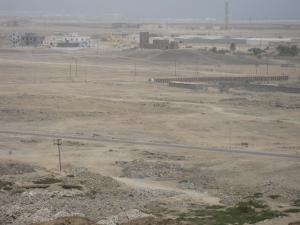
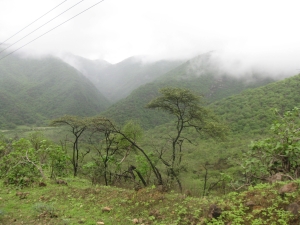
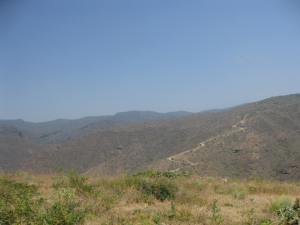
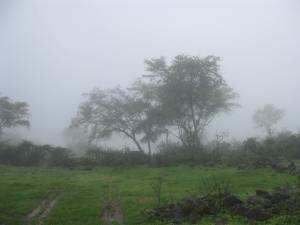

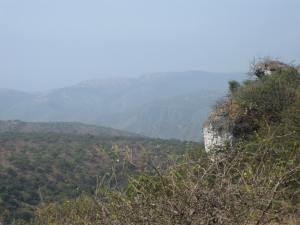
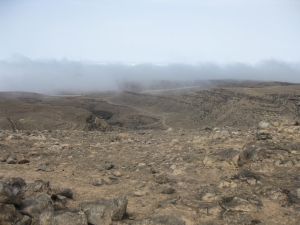


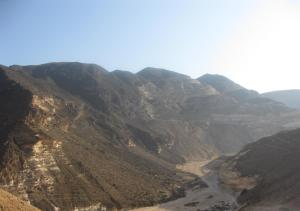
You have failed to acknowledge the huge role played by 22SAS in winning Dhofari ‘hearts and minds’ during the war, to the extent that, from 1979, they were tasked by HM to raise a SF answerable only to him in the image of the SAS, using the hardcore of previous antagonists, adoo and firqat. This was primarily in order to bring together these two opposing groups in a role committed to HM and the Sultanate. With the SAS close links to the Dhofar people from the past, this proved most successful and was a major step in ensuring a lasting peace between the opposing elements and within the Province of Dhofar. Later, bringing in those from North Oman this force greatly assisted in cementing links between the North and South of the Sultanate.
LikeLike
Thank you, Keith, but this is not an article about the Dhofar war itself, but about the effects of terrain on combat operations, and how a battlefield tour can be used as a teaching tool for military history.
In my forthcoming work I am also arguing that the significance of ‘hearts and minds’ has been overrated, and what the archival evidence reveals from Kew and other sources is that the victory over the PFLO was due mainly to conventional military operations by the SAF and the Iranians to expel the insurgents from Dhofar.
Furthermore, civil development projects aimed at raising living standards across the Sultanate (not just Dhofar) were actually very limited in scope, as defence expenditure took the lion’s share of revenue until late in the war. Indeed, by the conflict’s end the then-Chief of the Sultan’s Armed Forces (Maj-Gen Ken Perkins) was privately expressing concerns about the lack of progress on socio-economic development, and the fact that the limited extent of civil affairs work was such that the Dhofaris were losing faith in the Sultanate. He was also reporting that the PFLO still had a network of sympathisers within tribes that were nominally under government control.
This is not to denigrate the efforts of SAS veterans, but my argument is that the significance of their work has been exaggerated and treated as decisive in its own right, rather than being part of a collective war effort to defeat the PFLO. I would also add that such a view of the conflict does not give sufficient credit to the Omani Arab and Baluchi soldiers of the SAF who bore the brunt of the war effort, particularly in the bitter battles in the West in 1974-1975.
LikeLike
[…] My last post on Defence-in-Depth described a battlefield tour of Oman, studying the Dhofar conflict waged between insurgents and the Sultanate from the mid-1960s to late 1975. Thanks to the declassification of British government archives under the 30 Year Rule we now have greater knowledge of the covert operations conducted during this conflict, in the form of cross-border raids conducted into the former People’s Democratic Republic of Yemen (PDRY), otherwise known as South Yemen. This has been the subject of an article recently published in the Middle East Journal. […]
LikeLike
Greetings, I have a lot of photos from Dhofar from 1974. Was with 2 troop, 48 Field Sqn. of the Royal Engineers. I also had the privilege of meeting some of the BATT guys and other specialists, while I was there.
Best regards,
Sid
LikeLike
Thank you for your message, Sid. I’m very interested in talking to ex-RE personnel who served on Op TENABLE, and if you wish to do so you’re welcome to contact me on my work email, in the link below.
With best wishes,
Geraint Hughes
http://www.kcl.ac.uk/sspp/departments/dsd/people/dsd-a-to-z/hughes.aspx
LikeLike
Do you remember any of the names who served? My husband served April 1974 but army disputes his involvement and they’ve lost his records
LikeLike
My husband was there but cannot get recognitiion – can you help?
LikeLike
Hi Sid it’s possible you met my uncle in Dhofar sadly he died out there in March 1974 at the wadi sha ath was with the batt team a sq 22 sas his name was curly Kent the day in question is spoke about in the book called in the service of the sultan written by a guy called ian gardener would you be as kind to share some photos with me yours Jason
LikeLike
Hi Jason, Sorry about the delay in getting back to you. I forgot to tick the box to be informed when someone posts here. There are hundreds of photos from the Dhofar war on my Facebook group called “The Dhofar Insurgency 2”. I was with 2 troop 48 Field Sqn. RE from Ripon. We were there in 1974, and spent most of our 4 month tour working on the Hornbeam line. You are welcome to join our group and look through the photos and comments. I took about 180 plus slides while I was out there.
What was your uncles job in Dhofar?
Best regards,
Sid
LikeLike
“Is anybody out there?”
LikeLike
[…] matters of judgement, decision-making, command relationships and the military/political interface. Tactical actions can still be hugely informative of course, particularly for land commanders, but they need to be […]
LikeLike
[…] defensive positions with interlocking fields of fire (a challenge in its own right because of the tough terrain) they were unable to fire and manoeuvre in battle, and under fire their troops tended to bunch, […]
LikeLike
FYI May 1966 a full strength platoon from 2 Para was deployed to Salalah from Bahrain as protection for the airfield. I have many photographs of this period. Interested?
LikeLike
FYI May 1966 a full strength platoon from 2 Para was deployed to Salalah from Bahrain as protection for the airfield. I have many photographs of this period. Interested?
rodscott@talktalk.net
LikeLike
Greetings, one and all. Just to let you know that I have started a Facebook group called “The Dhofar Insurgency 2”.
Kind regards,
Sid
LikeLike
Nobody on here?
LikeLike
Greetings to all in this thread, especially Sid Pass, whom I thank for his welcome & interesting post about that Facebook group page. Have searched, without success, inside FB for that group. Accordingly, would be most grateful if someone could send the exact URL connecting to that group to me at .
LikeLike
Hello all who are interested in the Dhofar war. There is a forty minute documentary called ‘Operation Oman’ available for downloading on Amazon UK. This is not a history of the conflict, but one officers return visit after forty years. Well worth watching with some good original footage from the early seventies.
LikeLike
See also ‘ Storm Front’ by Rowland White for an account of the the period 1970-72. Mainly SAS and SOAF but eminently readable setting the flavour of the conflict.
LikeLike
The good the bad and the ugly.
LikeLike
[…] his son Qaboos bin Said; in its aftermath, the UK committed 22SAS as part of a wider effort to help Qaboos defeat the Dhofar insurgency and stabilise his realm. Officials in London and the Political […]
LikeLike